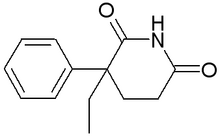Glutethimide
Glutethimide is a hypnotic sedative that was introduced in 1954 as a safe alternative to barbiturates to treat insomnia. Before long, however, it had become clear that glutethimide was just as likely to cause addiction and caused similarly severe withdrawal symptoms. It was originally a Schedule III drug in the United States under the Controlled Substances Act, but in 1991 it was upgraded to Schedule II more than a decade after recreational abusers discovered that combining the drug with codeine produced a euphoria which closely resembles that obtained from heroin. more...
Glutethimide is a Schedule III drug under the Convention on Psychotropic Substances. Doriden is the brand-name version of the drug, which is rarely prescribed today.
Read more at Wikipedia.org



